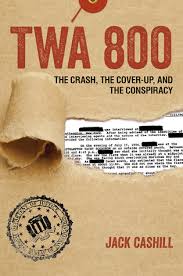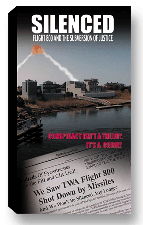What Woodward Saw in the Clinton White House—And What He Missed
![]()

Order Jack Cashill's latest book, TWA 800: The Crash, the Cover-Up, and the Conspiracy
![]()

About Silenced: Flight 800
and the Subversion
of Justice (DVD) -
-Buy the Silenced DVD-
![]()
© Jack Cashill
September 7, 2018 - AmericanThinker.com
"It's very depressing. You want to read a depressing book, this is it," said one critic of a book by Bob Woodward. "It's a sad, horrible story with all the sordid details that I guess people will just, you know, slaver over, but the fact of the matter is, it's humorless and there's no warmth."
In his criticism of Woodward’s book Wired about his friend John Belushi, Dan Akyroyd captured the essence of the Woodward writing style: lots of little trees competing for air in a gloomy forest often at the expense of the larger picture. One can expect the same from Woodward’s’ new opus about the Trump White House, Fear.
In his two books about the Clinton White House, Woodward again did a thorough job documenting the trees, but in the second of these two books, The Choice: How Clinton Won, Woodward missed a Watergate-sized forest, and, to his humble credit, he later almost admitted as much.
Woodward was no Clinton fanboy. In the first of the two books, The Agenda, Woodward detailed the chaotic run-up to the budget battle in Bill Clinton’s first term. In fact, he used the word “chaos” repeatedly, excessively even.
The process “bordered on chaos.” Clinton’s schedule “was again chaos.” Clinton pushed debate “to the point of chaos.” The administration’s first week “had been chaos.” The meeting dissolved “into virtual chaos.”
In the second of these two books, this one about the 1996 election, Woodward saw a White House teetering—you guessed it—“on the edge of management chaos.” He was not the only one to spot the disarray. In his memoirs, aide George Stephanopoulos called the atmosphere of the White House “dysfunctional.” And in his memoir Labor Secretary Robert Reich lamented a “chronically undisciplined president.”
What distinguishes The Choice is what Woodward missed. The Watergate reference earlier was not an exaggeration. The two years preceding the 1996 election were the most venal and treacherous in American political history, and Woodward overlooked it all.
The story begins on Election Day, 1994. “People are dazed,” wrote Reich. “No one had expected quite this.” In a time of peace and economic growth, Democrats had lost an incredible fifty-two seats in the House and eight in the Senate. “The election itself is being described as a total repudiation of Bill Clinton and the Democrats,” Reich observed at the time. “His presidency,” wrote Evan Thomas in his sympathetic account, Back From the Dead, “was in tatters.”
Just a week after the election, the Clintons headed to the one place in the world willing and able to bring the Clintons back from the dead—Asia. Joining them all at the Asian Pacific Economic Conference in Jakarta were the notorious Hawaiian fund raisers Gene and Nora Lum as well as any number of shadowy figures like Little Rock restaurateur Charlie Trie and Thai citizen Pauline Kanchanalak, both later charged by the Justice Department’s campaign finance task force with funneling hundreds of thousands in cash to the Clintons.
Most subversive of them all were James and Mochtar Riady and their DC point man, John Huang. For them, the White House was a wholly owned subsidiary. The Asians, of course, wanted something for their investments. For the Riadys it was a coal monopoly. For the Communist Chinese it was weapons technology. And what they wanted, they got. The Thompson Committee does a concise job of summarizing the process:
The president and his aides demeaned the offices of the president and vice president, took advantage of minority groups, pulled down all the barriers that would normally be in place to keep out illegal contributions, pressured policy makers, and left themselves open to strong suspicion that they were selling not only access to high-ranking officials, but policy as well. Millions of dollars were raised in illegal contributions, much of it from foreign sources.
The Clintons knew they could not win in November 1996 without Asian money. In a more disciplined fashion than they had done anything else since coming to town, the Clintons were going to use that money to launch what Senator Fred Thompson would call “the most corrupt political campaign in modern history.”
Adviser Dick Morris insisted on one strategy above all others: filling the airwaves with TV ads early and relentlessly. “Week after week, month after month,” wrote Morris, “from early July 1995 more or less continually until election day in ‘96, sixteen months later, we bombarded the public with ads.”
The strategy may have been illegal, but it was painfully simple, and it worked. To achieve “relative secrecy” Morris chose not to advertise at all in New York City or Washington DC and only occasionally in Los Angeles. “If these cities remained dark,” recalled Morris, “the national press would not make an issue out of our ads—of this we felt sure.”
“No one in the media really caught on,” confirmed Woodward in The Choice. The reason they did not catch on, as Morris well knew, was because they did not want to. The story the media chose not to watch unfold was an extraordinary one. The Thompson Committee summed it up:
The president and his top advisors decided to raise money early for his re-election campaign. To accomplish their goal, the president and his top advisors took control of the DNC and designed a plan to engage in a historically aggressive fund-raising effort, utilizing the DNC as a vehicle for getting around federal election laws. The DNC ran television advertisements, created under the direct supervision of the president, which were specifically designed to promote the president’s re-election.
In the afterword to the paperback edition of The Choice, Robert Woodward had the grace to admit he “vastly underestimated the significance of money” in the campaign. He noted too that the ads themselves “were deceptive enough to be appalling.”
Newweek’s Evan Thomas also admitted that “one of the great underreported stories” of the campaign was how the Democrats, not the Republicans, engaged in “the really effective negative campaigning.”
Neither Thomas nor Woodward explains why, during the campaign itself, no one in the major media chose to tell the true story.
An unprecedented series of untruthful, arguably illegal ads, which reached about 125 million Americans three times a week, should have been obvious to the media and scandalous from the outset. The scandal would have exploded if the media had asked where the money was coming from to pay for the ads and what the White House was using as collateral.
To get some sense of the media’s self-deception, one need only contrast the Thompson version of the campaign with the one captured by the staff of Newsweek. As Time’s Joe Klein told the story in the foreword of Thomas’s book, “Bill Clinton, by shrewdness, luck and love of the game, came back from a near-death experience to win a second term.”
And they want to impeach President Trump for what? Calling Jeff Sessions “mentally retarded”?

